High Voltage / Piezo Amplifiers & Signal Conditioners
Fiber Optic Links / Data Acquisition Systems
RF Power Amplifiers / Dual Directional Couplers
Instruments for Biological Science
Under Water Metal Detectors, Camera’s & Sonar Systems
|
Thermal Anemometry
AN - 1005 Hot-Wire Anemometry System
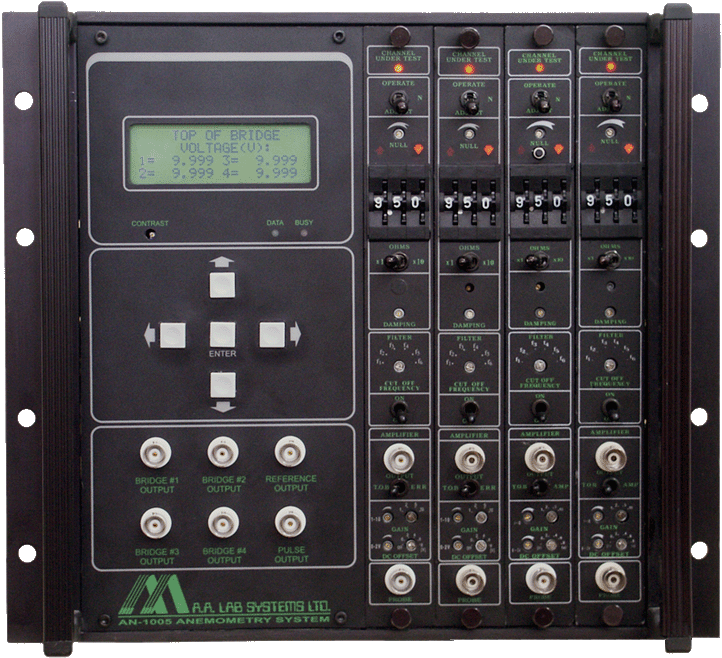 The AN - 1005 is a Portable Compact Thermal Anemometry System (Hot-Wire Anemometer and Hot-Film Anemometer), based on the AN - 1003 Hot-Wire Anemometry System Channels. The Hot-Wire Anemometer Channels Can work in CTA (Constant Temperature Anemometer) Mode as well as CCA (Constant Current Anemometer) Mode (with Option 11). The System has a built-in Microprocessor with Parallel Communication and Data Acquisition Capabilities. The AN - 1005 is a Portable Compact Thermal Anemometry System (Hot-Wire Anemometer and Hot-Film Anemometer), based on the AN - 1003 Hot-Wire Anemometry System Channels. The Hot-Wire Anemometer Channels Can work in CTA (Constant Temperature Anemometer) Mode as well as CCA (Constant Current Anemometer) Mode (with Option 11). The System has a built-in Microprocessor with Parallel Communication and Data Acquisition Capabilities.
The Mainframe use a Bright LCD Display to Display 4 Channels Simultaneously, using a 5-Digit Voltmeter. A Friendly built-in Menu guides the User through the Operating Procedure. All Analog Signals may be Measured on External BNC’s. However, a High Accuracy Data Acquisition System is built Inside the Mainframe, for High Speed Sampling at upto 500Khz @ 16-bit Resolution (1MHz @ 16-bit Optional). The Data Acquisition is done Directly to any Bi-directional Parallel Port, Eliminating the need for an Expensive A/D Card.
The AN - 1005 is an Ideal Solution for Most Fluid Dynamics Measurements and Aeronautics Measurement Applications. Based on a proven Thermal Anemometry Technique and Cold-Wire Anemometry, the System can Measure the Flow (Air or Liquid Velocity and Turbulence) and Temperature Fluctuations in Real-time, saving data to Disk or Displaying and Analyzing Data.
It’s built-in Optical Isolation Enables the user to get Clean Data, without Any Spikes, Bursts or Other Interferences Common to Anemometry System with a Standard PC Data Acquisition Cards. The Problem of Ground Loops, which Cause Oscillations and Calibration Problems is also Solved due to the Special Architecture and the built-in Data Acquisition System.
Smart Triggering and Clocking modes Enable the User to do Data Reduction as well as Synchronizing External Events to the Acquisition and Analysis / Display Process. This Feature is Ideal for Researchers and Experimentalist doing Fluid Dynamics Research with Machinery, Propellers, Bursts, Blow out Wind Tunnels, Valves, Actuators, Flaps, Stacks etc.
The AN - 1005 Anemometry System is an Advanced Hot-Wire and Hot-Film Anemometry System based on Today’s Technology. The built-in Software, as well as the Digital Hardware can be Updated using Flash Technology, and User may Download New Update Files to the AN - 1005, for Enhancing it with New Features.
- Features:
- NEW USB-2 INTERFACE!
- Portable System: upto 4 Channels
- Microprocessor Controlled
- Built-in Data Acquisition System
- Low Cost System
- Ideal for Research and Education
- Use the High Performance AN - 1003 Channels
- Digital Data Output: Directly to a PC Parallel Port
- Easy Operation: Friendly Interface
- Optional Thermocouple + %RH Sensor for Online Compensation
- Easy, Step by Step Calibration Software for All Probe Types, for Liquid or Gas, Velocity or Temperature
|

|
- Technical Specifications:
CTA BRIDGE
Non Linear, Constant Temperature Type |
Bridge Ratio: |
1:10 and 1:1 |
High Power Mode: |
1:20 and 1:2 |
Sensor Resistance Range |
1:1 Bridge: |
0.5 - 99.9Ω (Ohm) |
1:10 Bridge: |
1.0 - 9.99Ω (Ohm) |
Cable Resistance Compensation: |
0.2 - 1.2Ω (Ohm) |
Maximum Closed Loop Bandwidth |
1:1 Bridge: |
DC - 120kHz |
1:10 Bridge: |
DC - 100kHz |
With Option 04: |
DC - 500kHz |
Max. Probe Current |
x1 Drive: |
300mA Max. |
x2 Drive: |
600mA Max. |
Equivalent Input Noise |
1:1 Bridge: |
1.6nV/√Hz |
1:10 Bridge: |
2.2nV/√Hz |
With Option 01: |
400Picovolts/√Hz |
Typical Hum Induced in Input: |
0.03µVrms |
Typical Output Noise |
5µm Tungsten Probe:
OHR=1.5, U=0, B.W.=10kHZ |
135µVrms |
The same with Option 01: |
60µVrms |
Stability - Typical Input Drift |
1:1 Bridge: |
0.5µV/°C |
1:10 Bridge: |
0.3µV/°C |
With Option 01: |
Less than 0.1µV/°C |
Probe Cable: |
5m of RG174 or RG58A |
Output: |
Top of Bridge or Amplifier Output |
CCA BRIDGE
Constant Current Anemometer, OPTION 11 |
Fixed Currents: |
1, 2, 5, 10, 20mA and Any Combination of those Current Levels |
Variable Current Source: |
0.3 - 30mA |
|
Selected Current is Displayed on Test-module |
POWER SUPPLY |
Output Voltages: |
±15V, ±5V |
Maximum Current(@ ±15V): |
±2.5A |
Hum & Noise: |
<100µVrms |
SIGNAL CONDITIONER |
Output Voltage Range: |
±12V |
Amplifier Gain: |
1 - 20 (Pre-settable to any Gain in the Range)
(May be Ordered with 1 - 50 or 1 - 100 Ranges) |
Gain Accuracy: |
0.5% |
DC Offset: |
0 - 10V |
Output Impedance: |
100Ω (Ohm); 50Ω (Ohms) Available per request |
Input Impedance: |
10KΩ (kOhm) |
Typical Input White Noise: |
30nv/√Hz |
Frequency Range: |
DC - 100kHz |
Typical Equivalent Input Drift: |
160µV/°C |
LOW-PASS FILTER
Triple-Pole Butterworth Filter, with 12 Cut-off Frequencies in 2 bands |
Lower Band: |
300Hz - 5kHz (6 Frequencies) |
Upper Band: |
7kHz - 16kHz(6 Frequencies)
(Other Frequency Bands can be Ordered) |
TEST MODULE |
Pulse Generator |
Frequency: |
500Hz - 20kHz |
Duty Cycle: |
0.1% to 50% Continuous |
Rise Time |
50nSec |
DC Reference |
Output Voltages: |
0.1V |
Accuracy: |
100ppm/°C, 0.1% |
Data Acquisition |
Resolution: |
16 Bits |
Sampling Rate (Total): |
800kHz |
Sampling Rate - Pulse Response: |
1MHz |
Sampling Method: |
Quasi-Simultaneous.
Optional True-Simultaneous Sampling Available |
PARALLEL PORT INTERFACE: |
The Init Interfaces to EPP Parallel Port (Bi-directional Parallel Port found in any PC Compatible Desktop or Laptop Computer). |
Data transfer rate: upto 700KBps. |
USB2 INTERFACE: |
A High Speed USB-2 Interface Enables the AN - 1005 to Connect to any Portable or Desktop Computer with Ultra-High Throughput Rate and Fast Response Time. |
The USB-2 Interface may be Used with the Same Software or the Lab-View Driver |
- Sequential Sampling, Quasi-Simultaneous and True Simultaneous Sampling:
- Software:
 |
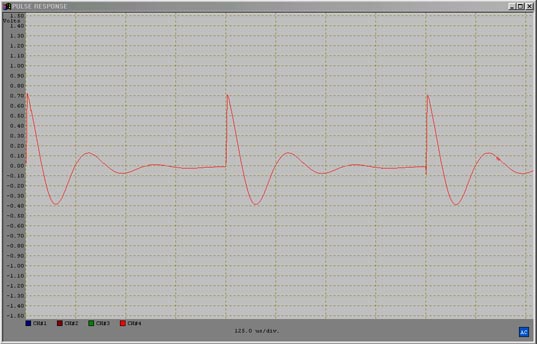 |
Real Time Display
Turbulence - on All Channels |
Pulse / Square Wave Response |
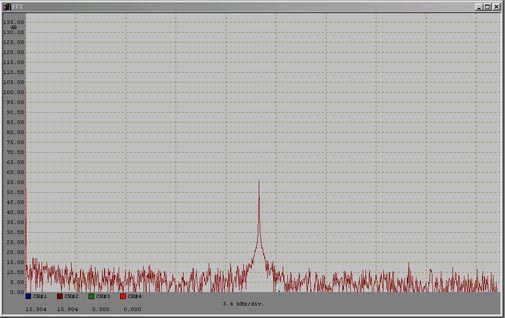 |
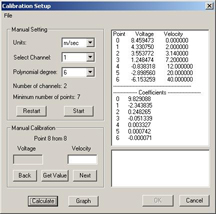 |
Noise Level - Less than 1mV ptp
Spectrum (FFT) |
Simple Calibration of Probes |
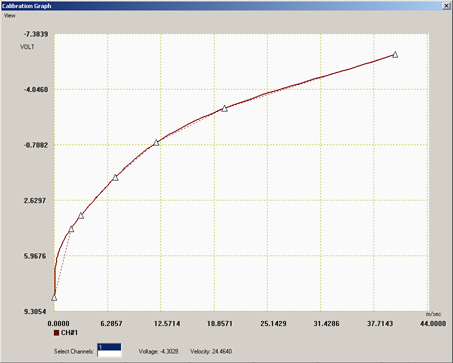 |
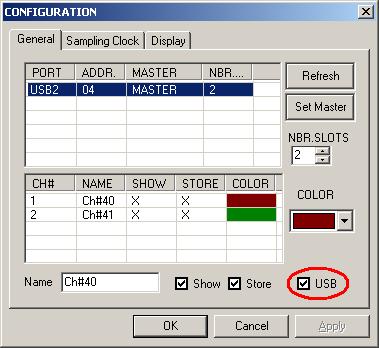 |
Calibration Curve is Exported via ASCII File |
Simple Calibration of Probes |
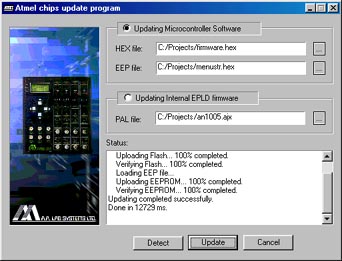 |
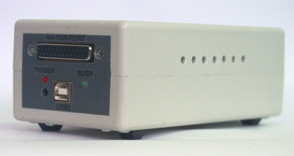 |
Software and New Firmware Updates Done by User |
High Speed USB-2 Interface Allows the User to Connect the AN - 1005 to Any Desktop or Laptop with USB-2 Interface for Faster Data Acquisition and Control of the Anemometer. The Analog Ground of the Probes Circuit is Optically Isolated from the PC to Prevent Any Transfer of Noise to your Sensitive Analog Signals |
All Specifications are subject to change without a Prior Notice
For any sort of clarifications kindly contact:
info@globesolutionz.com
|